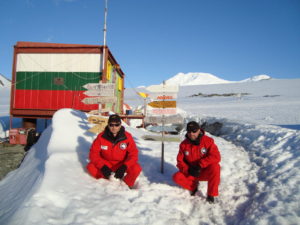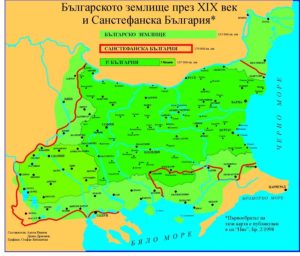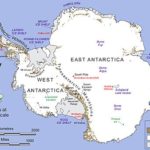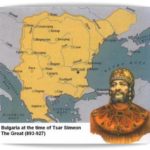
The following article was originally published in Serbo-Croatian by the online platform, Bilten. Its English version is published here with the site’s kind permission.
Around mid-December 2016 a news piece announced that a monument to the Cyrillic alphabet is to be erected in Antarctica. It is a joint Bulgarian-Mongolian project. The news about the monument raised some eyebrows as to the practicality of having a monument to the alphabet in a place with hardly anyone around to appreciate it. I will leave the issue of the “metaphysical” monuments and structures devoid of any function beyond a pure self-referentiality for another time. Here I will deal with two curious aspects of contemporary Bulgarian nationalism that the monument crystallizes: the erasure of the distinction between colonialism and irredentism, and between state-official and market-driven “revisionist” nationalism.
A proverb in Bulgarian nationalist discourse rationalizes the territorial ambitions plaguing Bulgaria’s relations with its neighbors like this: “we want only what is rightfully ours”. By “ours” nationalists usually mean territories roughly coinciding with (but not limited to) the “Greater Bulgaria” established with the San Stefano treaty of 1878 at the end of the Russo-Turkish war. It includes today’s Republic of Macedonia, some territories in Serbia that Bulgaria regained but lost after WWI, areas in Northern Greece and Macedonia again which Bulgaria occupied, when it entered WWII on the side of the Axis, and subsequently lost. A point of reference is also the territorial expansion during the “golden reign” of Czar Simeon I (893-927 AD) when Bulgaria expanded as far as today’s Albania and Romania, celebrated both in history textbooks and by nationalist subcultures.

One could easily relate the nostalgic Bulgarian nationalism for its Macedonian ‘hinterland’ to the imperial nostalgia of European colonialism but there is at least one important difference between Bulgarian and Western European conquests. The “rightfully ours” discourse considers Macedonians and Northern Greeks (so-called “Slavophones”) as “actual Bulgarians” whose identity has been changed into Serbian, Macedonian, etc. by enemy state propaganda. A common identity conveys at least a modicum of equality, despite the patronizing discourse of “they are Bulgarians, they just don’t know it because of enemy propaganda”. Whereas West European colonialism posited an irreducible difference between the European colonizers and the colonized; it was so to speak absolute difference, and the rise of racial theories came to explain away – but in reality construct – the hierarchical order between Master and Slave populations in the colonies.
Despite this crucial difference (among many others, Bulgaria’s dominated position in the international system), Bulgaria engages in something which reconciles the discourse of “we want only what is rightfully ours” with a practice reminiscent of European colonial expansion. Most fascinating of all is the geographical space where this articulation occurs: Antarctica.
 Thirty countries in the world have established and operate research stations in this most inhospitable place on our planet. Among them we find powerful capitalist states like the US, Japan, Australia, Belgium, China, the United Kingdom, Russia, Germany, Norway, and a few peripheral ones, such as Peru, Romania and Bulgaria.
Thirty countries in the world have established and operate research stations in this most inhospitable place on our planet. Among them we find powerful capitalist states like the US, Japan, Australia, Belgium, China, the United Kingdom, Russia, Germany, Norway, and a few peripheral ones, such as Peru, Romania and Bulgaria.
Of the ex-Eastern Bloc states, only Ukraine and the Czech Republic set foot in Antarctica after 1989; the vast majority of ex-Communists states established their research stations during Socialism. Bulgaria founded its station in 1988. In 1993 the first democratically elected President named it St. Kliment Ohridski, after the patron saint of Sofia University. Since 2005 the station sports the first Orthodox Christian church on Antartctica.
In 1993 the Bulgarian Antarctic Institute (BAI) was established as а not-for-profit association between various public and private institutions. It comprised the Sofia University and the Bulgarian Academy of Sciences, but also the so-called “Atlantic Club”, a civil society association, which lobbied tirelessly for the Bulgarian membership in NATO. In 1998 the Council of Ministers issued a decree with which it made the BAI the sole operator of Bulgarian activities in Antarctica. We could hypothesize that after the changes in 1989, the Bulgarian operations in Antarctica foresaw what would later become an explosion of public-private partnerships.
The station operates during the summer season, when an international team of researchers work on climate research, biology, geography, etc. In addition, the scientists engage in exploration of the continent. The discovered areas, glaciers, peaks, rocks, islands ridges, and so forth are given names by the researches. These names often relate to localities or villages in Bulgaria; just like the European colonists treated the places they occupied as tabula rasa and named them after their own towns, kings, countries, i.e. New England, Louisiana, and so on. On Bulgarian Antarctica we also find a variety names of national-liberation heroes, medieval rulers, ancient towns but also socialist-era seaside resorts such as Albena.[1]
According to the toponymic guidelines of the Antarctic Place-Names Commission of Bulgaria (originally affiliated with the BAI but later transferred to the Ministry of Foreign Affairs), the names should “[r]elate to Bulgarian place names”. However, some of the Bulgarian nomenclature fashion toponyms after medieval places and 19th century national-liberation heroes in what is now the Republic of Macedonia.
In other words, Bulgaria is realizing its lost “Greater Bulgaria” dream by name-colonizing Antarctica.
 Other names relate to the mythical pagan gods of “ancient” Bulgaria and Thrace. There are 65 names of Thracian and Bulgar rulers (known in Bulgaria as “proto-Bulgarians”, Bulgarians à venir). Some of the names chosen and the explanations provided (in the official Antarctic gazetteer) point to the workings of a historical revisionism of sorts. For example, the official Bulgarian historiography recognizes the year 681 AD as the founding year of the (first) Bulgarian state, that is, when the above-mentioned “proto-Bulgarians” arrived to the Balkan peninsula from Asia and conquered the northeastern territories of the Byzantine empire. But there are competing theories enjoying wide market circulation that displace the founding of the Bulgarian state anywhere between 3000 BC and 165 AD. The Antarctic Commission rationalizes the naming of a point on the shore as follows: “named after the legendary Bulgarian ruler khan Avitohol [..] who laid the foundations of the Bulgarian statehood in 165 AD.”
Other names relate to the mythical pagan gods of “ancient” Bulgaria and Thrace. There are 65 names of Thracian and Bulgar rulers (known in Bulgaria as “proto-Bulgarians”, Bulgarians à venir). Some of the names chosen and the explanations provided (in the official Antarctic gazetteer) point to the workings of a historical revisionism of sorts. For example, the official Bulgarian historiography recognizes the year 681 AD as the founding year of the (first) Bulgarian state, that is, when the above-mentioned “proto-Bulgarians” arrived to the Balkan peninsula from Asia and conquered the northeastern territories of the Byzantine empire. But there are competing theories enjoying wide market circulation that displace the founding of the Bulgarian state anywhere between 3000 BC and 165 AD. The Antarctic Commission rationalizes the naming of a point on the shore as follows: “named after the legendary Bulgarian ruler khan Avitohol [..] who laid the foundations of the Bulgarian statehood in 165 AD.”
In addition to 165 AD, the use of the word “khan” in the above quotation signals further departure from the mainstream. The official title of these medieval Bulgarian royalties is (still pronounced) as “han”. “Khan” spread after 1989 with the proliferation of private publishing houses and retired engineers-turned-historians churning out esoteric-nationalistic revisionism of the official historiography.
Yet the distinction between the “revisionists” (driven by visceral rejection of what they consider “lies” of Communist-era historiography) and the official institutions is a bit artificial. For example, Petar Dobrev, a controversial historian who popularized the theory about “165 AD” and is published by the biggest private “alt-history” publishing house of Tangra-Tannakra is also a member of the Bulgarian Academy of Sciences. Similarly, the publisher is not some marginal-samizdat enterprise of a few “dissidents” and outcasts of the historiographical field, but a respected recipient of an honorary certificate (in 2002) from the Ministry of Education for its “contribution to the development and popularization of Bulgarian culture.” Considering the sheer number of names taken from the “magical” pre-681 period that adorn geographical localities, it seems that the “alt-history” peddled by the publishing house has made a breakthrough in Antarctica on an equal footing with names and events from mainstream history books such as found in the pantheon of the national-liberation struggle.
So we have the San-Stefano Bulgaria, only in Antarctica. The popular nationalist longing for a “tri-coastal” Bulgaria (referring to the “golden age” of Simeon I when the Kingdom bordered the Black, the Adriatic and the Aegen seas) can legitimately be corrected to “Bulgaria bipolar”. And in addition to spreading the word about the glorious Bulgarian history and its “khans”, doing science on Antarctica achieves the ideal of violence-free colonialism. The geography in Antarctica magically condenses Bulgarian-Macedonian history and geography, the official, as well as the alt-varieties thereof.

Jana Tsoneva is a PhD student in Sociology and Social anthropology at CEU, Budapest. She researches the latest anti-government mobilizations in Bulgaria and is interested in theories of populism, ideology and civil society.
Acknowledgment: The author extends her gratitude to Tchavar Marinov for his suggestions and help.
[1] The Bulgarian president too is invested with naming powers and can christen places on Antarctica by decree. Most recently, the outgoing president Plevneliev has named a bay after the late Yulia Gourkovska: a sailor, explorer and program director (1996-2001) in the Sofia-based think-tank of Center for Liberal Strategies.

